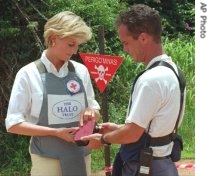2007年VOA标准英语-Work Intensifies to Clear Angola's Landmines(在线收听)
Huambo, Angola
24 July 2007
The world recently marked the 10th anniversary of the death of Princess Diana in a car crash in Paris. The late princess was a leading advocate against landmines, which kill and maim thousands of people every year. Shortly before her death, she visited Angola - one of the most heavily mined countries in the world. Correspondent Scott Bobb reports from Huambo, central Angola, that five years after the end of the Angolan civil war, efforts are intensifying to clear the mines which hinder reconstruction and threaten displaced people returning home.

Princess Diana uses a remote switch to trigger the detonation of some explosive ordinance dug up by mine sweepers in Huambo, Angola, 15 Jan 1997
It is midday in a field 30 kilometers outside Huambo. Carlos Silva, wearing a helmet, face shield and padded clothing, is crouched over a patch of scrub grass with a metal detector.
Silva has located an anti-personnel mine, one of more than a million placed during Angola's 27-year civil war.
He is one of a team of 70 de-miners of the Halo Trust working in this minefield. It contains hundreds of mines laid two decades ago to protect a satellite station.
Silva digs carefully to expose the side of the mine. If he touches the detonator on top, the mine could explode. It is slow work. A de-miner working under reasonable conditions can cover only a few dozen square meters a day.
Since 1994, Halo Trust has destroyed more than 30,000 landmines, several hundred bombs and hundreds of thousands of weapons and ammunition rounds.
Mines were laid along roads and railways and around many communities in Angola. Five years after a peace accord ended the war, only a fraction of the mines have been removed.
A few kilometers away, another team is clearing mines from around electrical power poles.
In these situations, de-miners use armored earth movers to clear large numbers of mines quickly. This front loader scoops up piles of contaminated earth and spread it in a thin layer on the ground so de-miners with metal detectors and rakes can check it for mines.
Angola's civil war displaced nearly two million people and affected one-third of its estimated 12 million population. With peace, many people are returning to their villages and their fields. Increasingly they are coming into contact with these deadly relics of the war.
The project manager for Halo Trust in Huambo, Southern Craib (sic) says, because of peace de-mining, priorities are constantly changing.
"There has been an expansion, in terms of population, returning refugees, renewed economic growth," Craib said. "And, that is putting added pressure on land. Tasks [minefields] that were previously considered low priority are now becoming high priority and, if they are simply not cleared now, there will be accidents in the future."
The minefield around the satellite station became a priority after two people from a re-populated village nearby stepped on mines. More than one thousand mines have already been destroyed here. This day, five more are to be eliminated.
Site supervisor Antonio Alipio has been working with Halo Trust for nine years. He is one of 1100 Angolans and seven foreigners working for Halo Trust.
Alipio unlocks a box containing explosives that will be used to destroy the mines. Carefully he measures fuses about one meter long and tapes them to the charges.
Alipio sets a charge beside each of the five mines and lights the fuses. He has three minutes to move a safe distance away.
He counts the explosions and, afterwards, inspects the fragments to make sure the mines have been completely destroyed.
Alipio has destroyed thousands of mines in his time. He is proud of his work.
He says, with more than 1,000 mines, one can imagine many people would have stepped on them. Many would have died and many would be amputees. But, he says because of his work, many lives have been saved.
Craib says, at this rate, it will take four to seven years to clear the high and medium-priority areas in Angola. Low priority areas in remote, uninhabited regions will have to wait.
"There is an achievable end state that can be reached," Craib said. "It simply needs continued support of donor governments and the international community and the population of the richer nations in the world to achieve [solve] a problem that is experienced largely only in the third and developing world."
The Angolan government is anxious to clear the minefields, because they hinder economic recovery and the preparations for national elections next year. But, for the de-miners, the primary goal remains to prevent any further loss of life, as Angolans struggle to recover from the devastation of war.